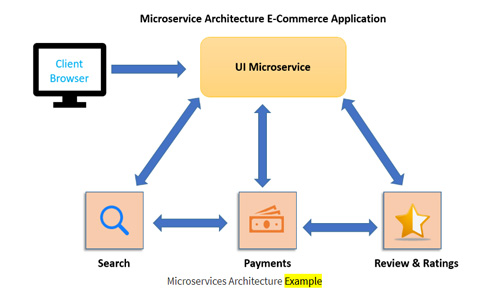Difference between Monolithic and Microservices Architecture
Hi there!
Microservices are a profound change in how the IT functions and brings a digital transformation in how the business works.
It is an important trend in the IT industry and one can have many different implications of this architecture.
What do you mean by Microservices?
Microservices or microservice architectural style is an approach to developing a large single application as a suite of modular components (or small services) in such a way that further each running in its own process, supports business goal or a specific task and uses a simple, well-defined interface, such as an API, to communicate with other sets of services.
Note: – It is also named as Microservices Architecture.
Software development has evolved drastically over the years and with Microservices vs Monolithic architecture, there is a fundamental change.
Big digital companies like Netflix, Amazon, Google and many others, have successfully adopted this type of architecture in their business.
Monolithic Architecture:
An application built as a single unit is called ‘monolithic application’.
A basic enterprise application must consist of three components:
- Database
- Client-side user interface
- Server-side application
Lets brief!
- Database- It consists of SQL and no-SQL database.
- Client-side user interface- It consists of JavaScript running in the browser and HTML pages.
- Server-side application- It will handle HTTP requests, works on executing domain-specific logic, manage the data from the database and works on HTML views to be sent to the browser.
A monolithic application uses a single development stack i.e. JEE or .NET which limits the availability of the right tools to develop the software.
In order to make any changes to the system, the server-side application must be built by the developer and deployed to the systems.
These three components bundled together becomes a Monolithic Application.
Monolithic Architecture Example or Examples of Monolithic Architectures:
Like a Java web application consists of a single JAR file that runs on a web container such as Tomcat.
Microservices Architecture:
Wherever we talk about Business-oriented APIs, it plays a vital role.
A core business capability is packed together to become valuable assets to the company.
When we talk about implying this, integration with systems of records is hidden as the services are written purely in business terms.
Microservices, because of their business-oriented nature become susceptible to use in multiple contexts.
The same services can be used all over again with some other business profile, business channel or any digital touchpoints based on the needs of the software.
The business-oriented APIs are deliberately standardized so that the consumers are not affected by any changes implied in the usage of the service.
In addition, this allows the user to make changes to the systems of records or change the system composition without any visual impact as all of it hides behind the interface.
This is the simplified explanation of Microservices Architecture.
Microservices Architecture Diagram:

When to use microservices architecture?
See, microservices capable of bringing scalability & agility benefits in comparison to any other available paradigm, so always consider adopting for applications that have deep requirements in these areas.
Open source communities & vendors are trying to simplify adoption of it by developing such platforms & frameworks for the same. However, while they are maturing rapidly, complete and robust mainstream platforms are probably at least a year away.
For building infrastructure for the same, it requires integration of many essential supporting tools to create what Gartner calls the “outer architecture.”
It delivers the platform capabilities needed to help microservices work together to deliver flexible development as well as scalable development and deployment too.
A number of organizations, however, are not having the type of web-scale agility & scalability requirements that further push teams to acquire microservices.
Therefore, never bait yourself into the trending hype flood to acquire the paradigm only either it due to the new entry or it made the talk of the town.
Find other ways to increase agility like do focus on development & deployment agility of larger components before attempting to do it for a swarm of dynamically evolving microservices.
It also noted out here that a number of organizations realized that microservices are too expensive & complex in nature and also disruptive to deliver the ROI required.
Meanwhile, organizations can derive tremendous value from the miniservices model, which advocates a more pragmatic, coarse-grained services approach with relaxed architectural constraints.
What are the advantages of microservices architecture vs monolithic architecture?
Or
What are the microservices architecture benefits?
The benefits of microservices vs monolithic architecture are significant when it comes to the business perspective of the system. It brings immense value to the business, expressly in terms of technical debt, and confirms a substantial increase in efficiency of the business.
A microservices-based architecture overcomes some of the issues in monolithic architecture that may create technical debt and increase its efficiency to a significant result, saving cost, time and speed.
Apart from this, there are other essential benefits of using it that are as follows:-
- AGILITY
This means that by using this type of architecture, the functionality of the system is broken to the basic level and then the developers can abstract the related services.
The agility of the architecture lets the developers focus on the important pieces of information so they can make relevant changes to the application.
The monolithic application offers integration and that time is not to be wasted with microservices based architectures and instead of months, the process may be done in weeks.
- REVENUE
Revenue can shoot above by reducing the downtime of the application and increasing the iterations.
The efficiency can be achieved by improving user engagement and user retention effectively.
- EFFICIENCY
It improves the efficiency of the system by use of code and hidden infrastructure.
A particular application requires infrastructure and cost-saving by 50% in case of it that can result in great efficiency of the application.
- RESILIENCY
Focusing the application functionality in a single channel may risk its integrity; it is always beneficial to disperse the functionality across various services.
The run-time of the application may increase significantly for better performance.
For instance,
Technical debt is measurable in the case of monolithic application as a traditional concept used by developers.
In the case of monolithic code, the partitioned components share the same memory and have access to the program as well.
This makes it easier for the developers to code the functionality of the system and implement applications.
It takes away the agility that should be a part of the developing process and this particular issue is resolved in microservices based architecture applications.
Tell some microservices pros and cons:
Some pros and cons are written below:-
Pros:-
- Deployed easily
- Less development time required
- It works well with containers
- Scale quickly
- Reused in different projects
- Better fault isolation
- It can be deployed in relatively small teams
Cons:-
- Potentially too much granularity
- Complex testing efforts are required
- Extra effort designing for communication between services
- Latency during heavy use
- It takes extra efforts while designing for communication between services.
[Also Read: How to Make a Dating App like Tinder in a Low Budget?]
Microservices Architecture Example or microservices example:
See, in the below example diagram, each microservice is focused on single business capability. Rating & Review, Search and Payment each have their server and communicate with each other.

Conclusion:
Organizations who wish to maximize its productivity in a positive direction preach customer satisfaction, for the benefit of the customer, have an eye beyond the traditional monolithic web applications and use the opportunities provided by microservices-based architecture for the increased efficiency of the business.
A microservices application must use cloud deployment technologies, API management tools and integration technologies to approach a successful perspective to application development.
Well, really thanks for reading the same till the end.
Hope you came to know about lots of things about it.
If you still have any query let me know into the below comment box.
I will answer you at the earliest, surely.
Have a nice time ahead.

